Ruth Knafo Setton's Blog, page 5
September 8, 2014
Gdansk: Yesterday & Today
 Angel casting away the sinners in Hans Memling's The Last Temptation
Angel casting away the sinners in Hans Memling's The Last TemptationYesterday:
Okay, there’s a darkness here I wish I didn’t have to acknowledge. I call it the creep factor. It lurks behind the deep yellow, rust & green painted facades of the buildings in Old Town, threads through the black veins of amber, & burns in the eyes of the damned in Gdansk’s masterpiece, Hans Memling’s The Last Temptation. The creep factor reaches its zenith in the Artists’ Court, a vast hall decorated with enormous paintings (more tortured souls being dragged to Hell), large wooden boats suspended from high ceilings, old swords & weapons, & an armored warrior looming over us on a high landing. I imagine him glaring though it's hard to tell, his head being a deer’s, crowned with antlers.
Staring up at the deer-soldier, I tactfully ask our guide, Kristof, “Was the deer a noble animal?”
“No,” he says, “but hunting in the forest was the most noble act of all.”
A medieval hunting lodge, that's what this is, where apparently town leaders still welcome important people & heads of state to gather & drink.
Outside on the main street of Old Town, the sun shines, a guitarist strums a waltz, tourists bite into succulent pierogies at cafes or lick soft ice cream cones as they saunter past souvenir shops & twinkling displays of amber. The Old World charm factor does serious battle with the creep factor, & believe me, I’m more than ready to be charmed. Why shouldn’t people sweep shadows & darkness under the cobbles? Shouldn’t they be allowed to forget?
After all, this curious little town was Danzig before it became Gdansk. Bombed in 1945. Scars remain. On our walking tour, Kristof takes us through one thousand years of Polish history—being tossed between Russia & Germany, & once even being erased from the map of the world—but he never once mentions the word, Jew. That loaded word, in itself potent enough to transform otherwise peaceful humans into antlered beast-faced monsters.
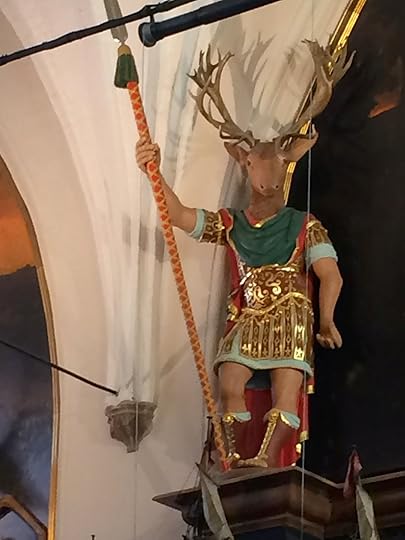
“There is a concentration camp 40 km from here,” says Kristof, without naming it, elaborating on who was killed there, or who did the killing.
I like Kristof, with his brush of dark hair, shy smile when we laugh at one of his jokes, & strange body tic—a swerve of his entire chest. He points out his wife’s favorite café, & the best place in town to eat pierogies: Udzika on Piwna Street, then steers us to one of the amber stores. Just doing his job.
Through the day I’ll eat pierogies (stuffed with chicken, raisins & nuts), drink Polish beer, linger at the amber stands, & gradually fall under the spell of desperately sweet confectioner’s sugar, sidewalk cafes, musicians serenading us with guitar & accordion, the piercing loveliness of the sunset over the bricks & cobbles, & the full moon peeking through the Ferris Wheel near the canal. It's an Old World elegance & charm I've read about & imagined, but never seen.
Still, I find myself wandering through the Old Town gates, leaving color, lights & people behind, to a darker, seedier area. I slow down before a group of tattooed, pierced, spike-haired teens smoking & laughing in front of a coffee shop, very different from the cafes in Old Town. Its scrawled window advertises “Okie Dokie.” A new kind of coffee on my endless search for great java through the world? From inside, George Michael’s voice blasts: “Freedom!”
And I keep going.
Today:
The morning sun is faint.
I sit at a cafe, munch a blueberry-crammed pastry, & watch the amber merchants, the guitarist, & the beggars, the cafes, storefronts & cobbled streets already growing familiar. I leave the main street & wander down the amber street, where a tavern dedicated to Copernicus is now known for its gingerbread. Another guitarist in a blue beret plays, "My Way" & "Sunrise Sunset." The open door to the Biblioteka beckons-- a library!
The instant I enter, the young man behind the desk leaps to his feet as if he were waiting for me & brings out a volume & sets it on the desk. "Look at Danzig," he tells me as I page through large black & white photographs of razed buildings & rubble. "Can you believe this is where you are walking now?"
"Hard to believe," I admit.
"They had a choice after the war--to start over & completely rebuild the town or to repair & construct over the ruins. They chose the second option, & I believe it was the right one."
Every volume in the small library, with a winding wooden staircase leading to the second floor, is about Gdansk & its history. The smell of books & fresh green air through the open window & door are my nectar.
The librarian asks eagerly where I'm from. "Pennsylvania?" he says, delighted. "The TV show, 'The Office,' takes place there."
Back on the amber street, the peaceful mood remains through the day, & every encounter I have with people of the town is pleasant.
My friend & I take the train to Sopot, a beach town 18 km. from Gdansk. We arrive in early evening to find a pedestrian street lined with the ever-present Lody ice cream stands, cafes, restaurants, & even an H&M. A festival is taking place that seems to connect gardening & youth camping, a live band with two horns plays Jorge Ben's samba classic, "Mas Que Nada," & everywhere, families stroll. Baby carriages, pregnant women with bellies thrusting under skin-tight leotards, old couples & young holding hands. As in Gdansk, I see many women whose hair is dyed red--a defiantly artificial translucent orange. The men at their sides are in baggy pants or dapper with creamy suits.
On our way to the beach, we pass the grand Grand Hotel, which sits rock-solid, protected by immaculate gardens, & faces the sea as if to say, "Don't dare try to get past me!" The hotel is enormous, a bastion of pre-war elegance that brings to mind Atlantic City's fabulous thousand-windowed hotels where Roosevelt & Truman stayed, & celebrities rode in rickshaws along the boardwalk. The Grand Hotel, Sopot, Old Town Gdansk are all trying to recreate pre-war elegance & charm, to open the story at "Once upon a time," before the children entered the dark forest.

Let's stay with them for a while, at least until the sun goes down.
the Grand Hotel in Sopot, Poland
Published on September 08, 2014 14:59
September 2, 2014
MOMENTS IN ST. PETERSBURG


Mermaid guarding the port, & Lovers on Nevsky Prospect guarding each other
I write everyday in my journal, but during this voyage I’ve decided to include one moment from each day that seems to capture the essence of the day & that moves me deeply. At the end of the voyage, I hope to have a cornucopia of memories. If you journal, it’s something you might consider. Already I find that it makes me more aware of each moment as something to savor & remember.
Three days in St. Petersburg gave a bouquet of moments. Rather than give you a travelogue, I’ll share four of my favorite moments. You should know that I did not have a visa, & hence could only leave the ship on Semester at Sea organized trips.
Moment 1: Nevsky Prospect, & my favorite shop so far—okay, the only shop I’ve entered besides a souvenir shop so efficient & prepared for swarms of global tourists it’s frightening—but I can tell. This is the store we all dreamed of as children—a confectioner’s shop with large glass windows in which mechanical figures dance. Enter from a cold, gray day into fragrant warmth & soft music … & the sight of exquisite pastries, extravagant chocolates, & desserts in an Old World atmosphere. I can imagine princesses dropping in for hot chocolate & marzipan fruit. We were given 10 minutes inside, & I had to be cruelly pulled away.
Moment 2: Descending underground on the longest escalator I’ve ever ridden on, truly into the Underworld. Standing in the metro, holding onto a strap & watching faces. Not many smiles, most expressionless or grim, & staring into space or into their own thoughts. I am struck by the contrast between the two St. Petersburgs I’ve seen: 1) the militaristic, futuristic Soviet architecture—rather dystopian & soulless, designed for dread; & 2) the French-inspired pastel-playful baroque & rococo palaces & churches blazing with light & incense, designed for awe.
St. Petersburg—located somewhere between Alphaville & Versailles.
Moment 3: Making wishes. So we’ve got the river Neva winding past old-time castles as frothy as confections in my favorite candy store in the world so far (& I didn’t even taste a sweet there, it will remain in dreams). Mermaids & Sphinxes guard the river, & lusty, enormous young Titans stretch outside an extension of the Winter Palace (the Hermitage). Touch one of their big toes, truly massive, & make a wish.
I did.
Also near one of the Sphinxes, where a lion-like creature opens its jaws, & you put your finger in & make a wish.
I never turn away from a chance to make a wish. It was the same one both times. We’ll see what happens!
Moment 4: And this is a city of wishes. One of mine was to see the Hermitage, & this morning I did. Dazzling, opulent, over-the-top, dripping gold—even more than the Vatican … a gold-plated peacock clock that fans its tail, an enormous chandelier (among what seemed like hundreds), intricately painted ceilings, vast windows that open to gardens or the courtyard that leads to the river …. Sculptures by Rodin, two paintings by da Vinci, & glorious art by Rembrandt, Titian, Caravaggio, Cezanne, Monet, & Gauguin—to mention some of my favorites ... but there’s so much, & I’m moving so fast through hordes of tourists, trying to keep up with the guide & one of those infernal hand-held devices with earphones that crackle more than communicate (for some reason my guide’s voice was replaced by a Japanese guide’s)…that I somehow get … lost. Or a little sidetracked, which may have been the best thing ever. I remove the head-ache-inducing earphones & wander with a fellow “lost” traveler through the French Impressionists’ rooms at my own pace, & even have a chance to buy a cup of the best coffee I’ve had since I left home.
So here’s my fourth moment: coffee & art at the Hermitage. Delicious perfect coffee & the dazzle of the some of the world’s most brilliant art housed in the Winter Palace.

The Hermitage
Moment 5: You might think it would be Catherine the Great’s Palace—more opulent gold & crystal, one dining room after another—each with its own set of china—& a room made of amber, thirteen shades of amber, a glittering gold-dark mosaic. Or Peterhof—Peter’s glorious park of fountains with gold-plated bronze mythological heroes, trick fountains that splash you without warning, a chessboard fountain, & winding paths that lead to the Gulf of Finland. But it’s the forest of tall, narrow birch trees we passed on the return to St. Petersburg—trees like guards hiding secrets, maybe fairy tale monsters.
And I’m going to cheat & add one more moment that came during an hour of freedom. We returned to Nevsky Prospect at night, where a long-haired electric guitarist played “Beat It,” while a pony-tailed artist sketched him, seated artists sketched portraits, people smiled, a couple kissed, & the candy store beckoned & twinkled. Two friends & I raced across the street like desert voyagers toward a mirage. In a race against time, our minutes of freedom ticking before we had to return to the ship, we ordered cappuccinos & a dark chocolate éclair topped with a marzipan colorful figure of an Art Nouveau woman. She melted on our tongues.
As we left, I took one last look over my shoulder. It means something, doesn’t it, when you taste food in the enchanted land?
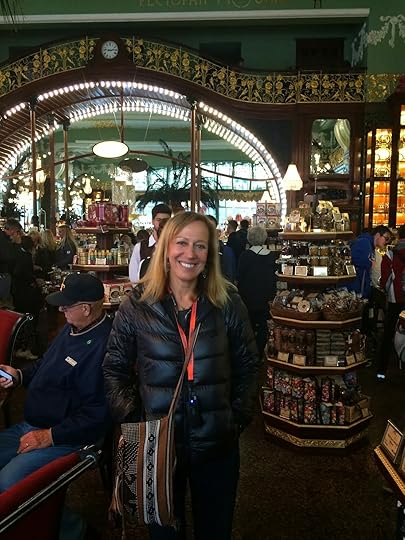
Published on September 02, 2014 21:40
August 26, 2014
FIND OUT WHAT LOVE IS
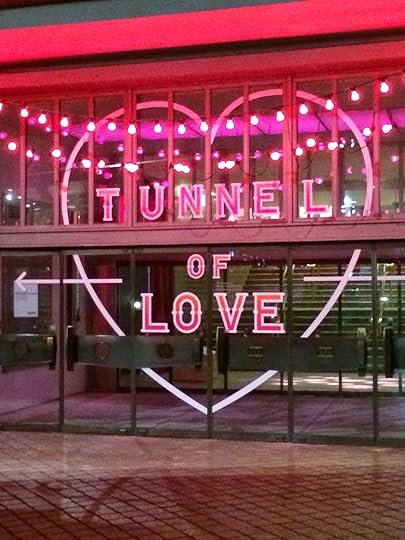
“FIND OUT WHAT LOVE IS” beckoned a sign on London’s South Bank, along the Thames.
Naturally, I couldn’t resist the invitation, but the building was closed for the night, & I was leaving London the following morning, so I’d have to find out for myself the secret to love.
My lovely niece, Natty, & her boyfriend had taken me for a walking tour of downtown London at night. It was two days before I boarded the MV Explorer in Southampton. We wandered around the South Bank & discovered the invitation to love was a summer event consisting of art installations, romantic black & white Hollywood movies, rides, activities, & even outdoor furniture designed to bring people closer together. The goal was to explore love—not just romantic love, but the more sophisticated, complex, subtle ways the ancient Greeks viewed love. At least six kinds, each offering us food for thought:
1. Eros. Sexual passion. Not seen as totally positive, but more as an uncontrollable force that can lead to danger & madness.2. Philia. Deep friendship. Loyalty, camaraderie—this kind of love was valued more highly than eros, & considered more trustworthy. I’m not sure how the ancient Greeks would have viewed Facebook friends!3. Ludus. Playful love. The joyful exuberance of children & young lovers. A sweet innocence we should strive to recreate in our lives.4. Agape. Selfless love. Love for all humanity. Perhaps the highest form of love. It was translated into Latin as “caritas,” which later became our: charity. The concept of lovingkindness & compassion to all.5. Pragma. Longstanding love. The mature love of couples who have been together a long time & who have withstood trials, sufferings & joys … & managed to stay standing. A beautiful idea that our culture doesn’t value enough.6. Philautia. Love of the self. This is a tricky one because it can be split in two: 1) overwhelming love of the self that leads to narcissism, constant “selfies,” & putting oneself first at all times; & 2) a necessary, important self-awareness & tenderness to one’s self. We can’t care about others until we learn to care about ourselves.
All this recreated on the South Bank! As we explored, it struck me that I’d found the underlying theme for this voyage, & for my travel blog: to travel by sea the way the ancient Greeks did, to seek out fellow & sister humans, & in the words of E.M. Forster, “Only to connect.”
Published on August 26, 2014 03:11
August 24, 2014
HERE WE GO!

The MV Explorer, a floating university, & my home for the next three & a half months.
We are docked in Southampton for the next few hours, setting sail at 1700 hours (5:00 pm), Sunday, August 24th, for St. Petersburg, our first port. We'll travel to fourteen countries.
I'm writing this at a coffee shop facing a pedestrian street with food stands-- my last minutes on dry land for the next week or so.
I've had a couple of days to explore a bit of Southampton, & I particularly enjoyed the Old Town near the harbor. Apparently both the Mayflower & the Titanic sailed from here. Hmmm....
Hope our voyage will be a safe one in all respects.
I was fascinated by the many mentions of Jane Austen, little plaques announcing that she went to her first dance at this hotel, or spent time with her family at another spot... kind of like "George Washington slept here."
Anyway we have all boarded the ship-- that's 620 students from all over the world, 45 faculty & staff, 14 Lifelong Learners, & 330 crew members. That's a full house, my friends. Tomorrow morning, classes begin, & just to give you a sense of shipboard schedules: while at sea, classes follow an A Day, B Day schedule. No weekends, no days off. I'll be teaching 3 courses: 2 sections of Travel Writing, & 1 of Creative Writing: Fiction.
I spent a day in London before coming to Southampton, & while there, got inspired & developed an idea about how I want to structure my first-ever travel blog. More about that in my next post.
Meanwhile it's been all about adjusting to life on the ship again. This is my third voyage, but each one is different-- the voyagers, the itinerary, your own goals & desires during the trip.

Coming down the gangway for the first time in Southampton.
I look forward to meeting new people, forming new connections all over the world, making new friends & seeing life & our world from different perspectives. Travel is learning about yourself while you are learning about the world. And traveling by sea-- well, there's something about facing that view-- the sea & sky-- that gives you space to dream & imagine new realities & possibilities.
So ... here's to possibilities! I hope you'll travel along with me, & let me know if there's anything you'd like me to write about or anything you'd like to know! Till next time ....
Published on August 24, 2014 06:19
August 18, 2014
FIND YOUR RHYTHM

Four years ago I had a major cerebellar stroke. That stroke taught me how to write.
Fear and ancient anxieties grew a dark forest between me and my writing desk. If I mustered the courage to battle those strange wild creatures who lurked in that forest and get myself, my bum, into the desk chair, the quiet blankness of that space soon filled with strangling tendrils that shook me with … Well, perhaps some of you recognize it. Sometimes such fairy-tale images help give expression to that simple little thing some folks call “writer’s block.” I never liked that phrase. It seemed to trivialize whatever it was that grabbed hold of me. I’ve spent a lot of focused time not-writing. I’d become an expert at Not-Writing.
And then I had the stroke. After the ICU, after the all the tests, after I finally came home, I trucked off to Physical Therapy three times a week. There, I learned the secret to life … or at least to the freedom of writing.
The key lies in the rhythm. Not the rhythm of the words, the sentences (though that’s important, of course). The rhythm of time — of minutes. Therapy sessions lasted an hour. One exercise for five minutes, then the therapist would stop me.
“No, I can do more!” I insisted. But they made me stop.
A minute would pass. I’d stand, ready to do more work. But the therapist insisted that I rest for a full three minutes at least. Then, more work was allowed.
Five minutes on — Three minutes off — Five on — Three off — Five - Three. For an hour. This felt very wasteful to me. I only had an hour. Shouldn’t I make the most of it? With their little five-three system, I was getting only about thirty-five or forty minutes of work!
The therapists explained: The brain learns best is small bits. When a young child sticks her hand into a candle flame for the first time, she jerks her hand back and her brain registers “burn! hurt!” and learns not to do that flame thing with the hand again. If you work your brain too hard, re-learning all these things after a major brain assault, your brain actually learns not to do the things that hurt. The key is to work just long enough, just until the edge of the hurt. Then rest. Really rest — long enough to “forget” the work. The Rhythm Principle: Wash, Rinse, Repeat. It works!
So I began to apply the rhythm-principle to my writing practice. That primeval forest, those gnarling beasts—they were all in my brain, not in front of my desk. I’d been trying to “push through” the pain through sheer grit. Now I began to treat my brain—and my self—with more respect. I set a timer. I would write for eight minutes, then reset the timer and rest for seven minutes. Three or four rounds—a one-hour writing session. I eventually got up to a twelve-three format. Write for twelve minutes, rest for three. An hour every morning. And the most amazing thing happened.
I began to write. The pages piled up. Within a month I had a whole stack of rough-written pages. It was not painful! I found myself wanting to add an hour in the afternoon. It’s hard to be really awful in just twelve minutes. Ok, some of the pages were awful. But only twelve minutes worth of awful. Rest, forget, “rinse”—the next twelve minutes were, well, the next twelve minutes. Not the proverbial Great American Novel. Just the next twelve minutes.
Find your rhythm! Pushing through can be great if it’s getting you somewhere, if you’re running high on caffeine and imagination. Those manic stints can be invigorating and hopeful. Rest will follow. Rest must follow. The rhythm works in both micro and macro versions. I’d looked for a way to be “stable”—to write consistently, in a concentrated fashion, neither flying too high nor sinking into the doldrums. What my stroke taught me is that sometimes it’s best to alternate deliberately between ON and OFF. Finding my rhythm gives permission to both work and rest, to highs and lows, to energy and weariness. And, for me at least, finally makes writing possible.
Virginia Wiles
virginiawiles.com
Published on August 18, 2014 03:31
August 8, 2014
SEARCHING FOR BRAS IN THE FAR EAST
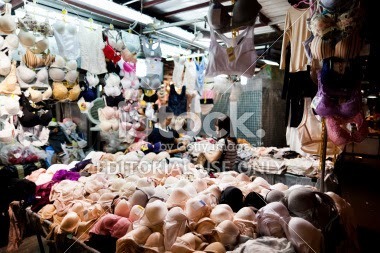
Sixteen years ago I sailed around the world with a single bra. If you don't wear a bra, try to imagine leaving for a 3 1/2 month voyage without something you need, that you wear everyday, particularly when traveling & hiking.
We embarked on the ship in Vancouver. Two hours before we set sail across the Pacific Ocean to Japan, I searched my suitcase for a bra. What the ... Where were they? I emptied the suitcase & stared at the mound of clothes. No bras. Not a single one.
I shut my eyes & pictured my bedroom so far away. My bras were tucked inside a satin pouch on my dresser. Why, why had I set them aside? What madness had possessed me? There they were-- my lovely rainbow of bras in cotton, silk & satin-- & there they'd stay, serenely awaiting my return.
I had 2 hours to find more bras. With my 12 year-old son in tow, I raced to a downtown street, but for some reason, I found only 1 lingerie store that carried a handful of bras as an afterthought. Strange, sturdy little bras with a red, white & blue insignia in the middle that looked like a tiny Canadian Mountie. I bought 1. I'll buy more in Japan (I told myself).
Ten days & 3 typhoons later, we arrived in Osaka. I'd washed & changed my 2 bras everyday, but the harsh ship water had already faded the Mountie. As soon as I stepped on land, I went in search of a bra.
I can't explain the scarcity of bras in Osaka. Or Saigon. Or Penang. With my son at my side (sorry, Avi, hope I didn't scar you with this quest), I searched for what was apparently the most elusive item in Southeast Asia: a bra, size 36B.
Not huge, not tiny, but medium-- right? Average.
 Not in Southeast Asia. Not 16 years ago, before Victoria whispered her Secret to the rest of the world. Back then, one of these stores would have seemed like a mirage:
Not in Southeast Asia. Not 16 years ago, before Victoria whispered her Secret to the rest of the world. Back then, one of these stores would have seemed like a mirage:A grim realization soon emerged. There were so few bras because the need didn't exist. By the time we arrived in Hong Kong, my 2 bras had lost their shape, the straps were fraying, & the Mountie looked like a grizzled old man. At this port, if no other, I'd find a bra. We docked at a shopping mall, for God's sake! And I had a handwritten note in Chinese: "Bra Store".
We made our way through colorful narrow streets crammed with people to a shop that indeed displayed lingerie in the window. I handed the saleslady my note. Behind a curtain, she & another woman examined me with a tape measure. After many fervent gestures & loud exclamations, one cried, "Ah! You need Queen Mama size!"
Me? Queen Mama?
With another Chinese note, & clutching my son's hand, I ventured down the chaotic streets, including one filled with birdcages & singing birds, to a tiny shop next to a man who sold squirming eels & squid.
An ancient woman read the note & nodded. She went into a back room & eventually returned with what appeared to be a small white knapsack, crisscrossed with bands & wires. "Queen Mama," she said proudly.
It gave me an odd shape, weirdly flat yet pointed, & was so tight she stretched it with a tool that reminded me of a dentist's probe.
Friends, I bought it. I'd have bought 2, but there was only the one, waiting in storage for Queen Mama to arrive.
I had many adventures during that voyage-- I crawled through the Cu Chi Tunnels, entered a Temple in Penang where the Priest threw a basket of live snakes at me, & dined in Saigon with a French woman who had spied during the war & whose young lover serenaded us with a mournful rendition of "Love Me Tender" on his guitar.
By the time we arrived in Italy, months had passed & I'd grown accustomed to my faithful 3 companions. We'd been through a lot together.
Ten minutes in Rome & I found a lingerie shop. Another 10 minutes, & I emerged with 2 shiny new bras. No Queen Mama, no Mountie. No giggling saleslady.
Almost too easy.
On my next voyage, I forgot to bring ... well, that's another story.
In a few hours I'll leave the US for 4 months. I stare down at my open suitcase.
I wonder what I'll be in search of this time.
Published on August 08, 2014 05:27
July 30, 2014
THREE PREPS FOR THE VOYAGE
 A little friend rests on my legs while I think about what to write next ...
A little friend rests on my legs while I think about what to write next ...We set sail on the MV Explorer from Southampton, England, on August 23rd. However, I'm leaving the USA on August 8th (that's nine days away!) for a two-week trip to visit family in Israel. From there to England, & then the ship. We return from the Semester at Sea voyage on December 8th, sailing to Port Everglades, Florida. August 8th - December 8th. A long time to be away from home.
July has been a month of Pre's:
1. PRE-paring ... for a four-month voyage. Mentally & emotionally preparing to be a traveler-- ready to meet new people & shift perspective, see the world from different angles, taste new foods, listen to voices speaking other languages, watch the sun rise & set over the ocean, & open oneself to new experiences. I try to be a traveler in my daily life, but sometimes it's a challenge.
Packing is another story, one I haven't tackled yet. Can I manage four months with a single suitcase? I know I'll be happier if I travel light, but ... I want my comfort clothes (my writing hoodie & sweats, etc), & I must pack fancy stuff for the Captain's Dinner & a wedding, & then there are my "things"-- non-clothing items from books to cosmetics. They'll easily fill half the case.
I'll tackle the suitcase(s) this weekend.
2. PRE-writing ... a new novel. Time presses on me from all sides, & all I want to do is plunge into the deep & just write, but for some reason I can't rush this one.
I'm thrashing through a jungle when I discover an ancient palace that bears the same inscription as the modern temple I left behind. How can that be? I lean closer to examine when I hear a sound.
Footsteps outside the clearing. Approaching.
Someone followed me, & oh God, it's not who I thought it would be-- it's -- well, this opens a new door to the story, & now I need to work on this angle.
More planning & plotting, researching, exploring options, contacting experts, reading & taking notes. Slowly, the world & its people are taking shape around me. I'm not trying to be cryptic here, but it's too raw & wild, too much in my imagination, to share. Yet.
But I'm bursting to write & forcing myself to hold back. Soon, I promise myself. I need to make sure the ground beneath my feet is solid because man, I can already tell -- this is going to be one hell of a journey.
3. PRE-tending ... my garden & my mind. Thanks to my friend & writing colleague, Virginia, for that term. Pretending is something I do very well, & if you're reading this blog, I'm sure you do, too. We know how to pretend a world into existence, but this magnificent ability to pretend involves pre-tending, too. I am watering my plants, savoring my garden & the calm of "before." It's not an empty time at all, not simply a waiting. It's another part of life, a "now" that feeds the soul & heart.
So that's where I am now. Getting ready for take off. In a new story. On the sea.
But that's tomorrow. When I'll bring out the suitcase.
Today ... is here now, me & this little dog watching each other at this exact moment. Pre-(I mean, Per--) fect ....
Published on July 30, 2014 06:23
July 23, 2014
PRACTICE MAKES ... PASSION
 This is not me, but how I often imagine myself when I'm doing yoga. Recently, I joined a class, & noticed the teacher describing our poses & movements as our "practice." This morning, when I sat to write-- as I do nearly every morning-- I realized that writing is also my practice.
This is not me, but how I often imagine myself when I'm doing yoga. Recently, I joined a class, & noticed the teacher describing our poses & movements as our "practice." This morning, when I sat to write-- as I do nearly every morning-- I realized that writing is also my practice.If it's a choice between writing & yoga (or writing & anything else), writing will always win out, but they both work on me in similar ways. Yoga stretches my body, & writing stretches my mind, & together they stretch my heart.
One of the reasons my six years of piano lessons fizzled out was because I never learned to look at piano lessons as a practice. Instead, I was bored by repeating the scales, & I was always preparing for a recital or program. It wasn't the road, but the inn at the end of the road. And if there was no inn, it all felts like a dead-end.
Now, I'm a traveler. It's in my blood, & when you are a traveler through & through, you know the journey never ends. The inn is just one stop along the way because the true voyage is within you. The country you are exploring is yourself. The voyage is your life.
There is no end to writing. I finish one book & immediately begin another. With yoga, I master one pose (speaking figuratively!) & immediately try to sink deeper into a pose or hold it a little longer.
Through the years I've come up with a few thoughts about practice. Here are seven that I hope will resonate with you:
1. Find your practice-- the thing that gives meaning & joy to your life. It may take years or you may stumble on it from the beginning. It doesn't matter when you find it or how it finds you. Whenever it is, it's the right time, & it's yours, & you begin at that point.
2. Practice doesn't always make perfect. I know this may sound harsh, but lazy or shoddy practice can lead to unsatisfactory, disappointing results. That's why it's better to take time to learn well from the start, if you can. Study the masters. Read the great writers, attend classes with inspiring teachers, & try to learn good form & the basic foundations of your art/craft/sport.
3. Practice your practice. Over & over. Regularly. Interweave the practice into your daily life until it becomes second nature. There will be monotony, distractions, jobs, responsibilities, etc. Hey, that's life. But return to it when you're ready.
4. Discipline is necessary, but if you are not self-motivated to continue, your practice will drop along the way. Your challenge is to find ways to make it new. Vary your routine. Shake up your practice by giving yourself prompts or assignments. Try a different teacher or class. Write in a coffeeshop or on a park bench if you usually write at home. Write with a partner if you write alone. Join a class if you practice alone. Play at your practice.
5. Focus. The key to a successful practice-- no matter what you're doing-- is being in the moment, concentrating on your goal, on what you hope to accomplish during that session. In yoga, focusing on your breathing becomes so natural you often carry that awareness into your daily life. In writing, you concentrate on the world you're creating. As the always wonderful Anne Lamott says, "You squint at an image that is forming in your mind -- a scene, a locale, a character, whatever -- and you try to quiet your mind so you can hear what that landscape or character has to say above the other voices in your mind.”
6. Practice may not lead to the "promised" goal: you may not become a yoga master or teacher. Your writing may not get the recognition you wish for or feel you deserve. Somewhere along the road of life, you need to examine who you are, what you need & can't live without, what makes life worthwhile. One step at a time. In the words of author E.L. Doctorow: "Writing is like driving at night in the fog. You can only see as far as your headlights, but you can make the whole trip that way."
7. Practice, for me, is a mix of passion & control. I stretch words as far as I can, twist them like elastic bands, snap & send them into the air. With yoga I'm much more aware of my limits, but I'm ready to explore & see where it takes me. Another word for practice is curiosity. I hope I never stop being curious.
Listen to Albert: "I have no special talents. I am only passionately curious." -Einstein
Published on July 23, 2014 09:22
July 16, 2014
GIRLS IN STRANGE LANDS
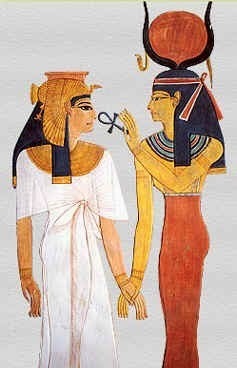 Isis gives the Ankh, "The Key of Life," to Queen Nefertari
Isis gives the Ankh, "The Key of Life," to Queen Nefertari Every book I write opens doors to different worlds. I begin with what I know, but soon I move into the realm of mystery & explore what I want to know.
In my last book I researched blues guitar, photography, jazz trumpet, city redevelopment, & how to run a restaurant-- among other things. For the new book, I'm beginning with two subjects I've always loved: magic & archaeology. My wanderings in magic will be the subject of another post, but archaeology, this time around, has led me to the history of the Goddess. I am utterly fascinated, blown away, by the richness of Goddess mythology, religions, rituals & history.
The glorious figures & paintings reflect an era of female power so natural & instinctive it shocks us in our supposedly liberated time. Here is the great Goddess of 10,000 Names, Isis, with wings, & surrounded by the emblems & tools of her power.

There are images of her holding & breastfeeding her baby, Horus, that demonstrate a clear path from pagan symbolism to modern-day religions as well as New Age mystical temples & rituals that return us full-circle to where we began.
One of my favorite images is the one at the head of this post, in which Isis transmits the Ankh-- the Key of Life, as well as the Key to spiritual knowledge, & the secret name of God-- to a female queen, Nefertari. I love this image because it shows Isis in one of her many roles: The Magician/Teacher/Mother who imparts secret knowledge to her Disciple/Sister/Daughter/Student. According to ancient Egyptian mythology, Isis was a girl before she became a God. After that transformation, she ruled Egypt with her brother-husband, Osiris. Their love story is one of the most beautiful & tragic in history. And of course it will be part of my book!
This image shows Isis at the height of her powers in Egypt-- before her power & reputation spread to the Greco-Roman Empire & throughout the world, even as far as South America. Before the "civilized" world destroyed her temples, burned her relics & statues, & tortured her followers. By all rights, she should be forgotten today, another goddess swept away by Time & the crusades of modernity.
Yet she is still here-- a formidable presence worldwide. There are many, many Daughters of Isis, many girls in strange lands who look to the Mother rather than the Father for knowledge.
Maybe because in her prime, in Rome, when Isis worship was more popular than Christianity, she welcomed women, prostitutes, slaves, & the poor into her temples. She did not discriminate-- all were welcome.
Maybe because even though one of her names was The Throne, when Osiris was murdered, she went mad with grief & tore through Egypt searching for him, tricking a god, using magic & rage & love to breathe life back into him.
Maybe because during secret rituals, she shared her wisdom with her Daughters, & they, in turn, shared it with their daughters (& sons). As we do.
Mother to Child.
Author to Reader.
Here is the Mystery. Shh. Pass it on.
Published on July 16, 2014 12:53
July 4, 2014
Layers of Human History
Guest post by Joyce Hinnefeld. Joyce is a a dear friend, a wonderful writer, & the director of last month's inspiring & amamzing Moravian Writers' Conference-- about which I've written on this blog. Take it away, Joyce!
My husband, twelve-year-old daughter, and I took a fabulous trip last summer, to Greece and Rome. In Greece we spent time in Athens, took day trips to Arachova and Delphi, then spent time on the island of Naxos and took more day trips, to Delos and Mykonos.
And let me tell you, I have got some photos! The iPhone makes it all too easy. But instead of the freshly whitened buildings with blue trim and Byzantine churches and countless cats, instead of the glorious statues of lions and gods and goddesses and the fragments of temples to Apollo, I want to show you this single photo from Greece, which I took outside the archaeological museum on the island of Delos. It’s of a rusted and clearly long-unused pay phone. Years of sun and wind and blowing sand have done their work on it. It’s a different kind of Greek ruin.
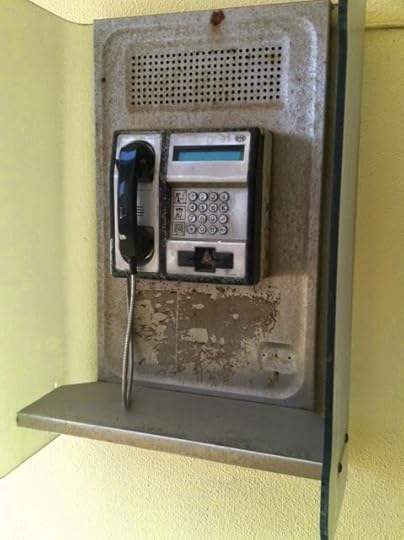
Ruth has been my inspiration and guide through the many years of our friendship in all kinds of ways, but maybe most keenly in her deep appreciation of travel--particularly the ways in which travel inspires her writing. Travel inspires my writing too, but I think the form that takes, for me, is different. Instead of imagining ancient worlds, charms and curses, mermaids and sultans and captive girls, I find myself--in the midst of all that beauty and history--looking at the two women (were they sisters? were they as sad as they seemed to me?) serving us breakfast in the hotel in Rome. The young man who sold ice cream and snacks on the small ferry boat, pedaling his bike furiously from the port, carrying a bucket for more ice during our stop on Mykonos. The beautiful French mother, with her two shy pre-teen daughters, at the pool on Naxos. Wondering what they had for breakfast, who was causing them pain or giving them joy, what they remembered fondly, what they wished they’d never done.
I don’t think my preoccupation with the present-day people around me when I travel comes from my being stuck in the present; I’m actually a very nostalgic person. That nostalgia keeps showing up in things I write lately. In fiction, it emerges in the mother-daughter relationships I keep including, with mothers remembering their own younger lives, and sort of understanding their daughters’ lives, but sort of not. That’s me thinking about my own daughter, I suppose. But I think it’s also me missing my own younger self.
In the piece I’m working on now, a mother and her college-age daughter take a trip much like the one we took last summer. Only in this case, they’re going to revisit scenes from a semester, and a follow-up summer, that the mother spent abroad thirty years before. She wants her daughter to consider studying in Rome; the daughter says she isn’t really interested in living in a dorm with other American students and studying that particular form of imperialism. On the island of Delos, while her mother tries to get her interested in the row of massive lion statues, glowing in the midday sun, the daughter snaps photos of a museum card that refers to the Athenians’ “overtly imperialist policy in the Aegean,” then the rusted pay phone. Later she posts both online with the caption, “Layers of human history . . . .”
The young man pedaling his bike away from the port will show up too, as will two middle-aged sisters serving breakfast in the little birreria next to a hotel called the Hotel Cinecittá in Rome (in reality, it was called the Hotel Fellini--but there really was a little birreria where we had breakfast, and it was filled with music stands and posters and books about Italian neo-realist cinema).
For a long time I haven’t wanted to admit how much the fiction I write has to do with me. My life, my preoccupations, my unanswered questions. But of course that’s what I’m doing, even when I try to imagine my way into the life of a sad and lonely Italian woman, or two Greek brothers who grew up on a farm on Naxos, or the American college girl who, one magical summer after a semester abroad in Rome, fell for the older brother.
But sometimes you need to leave home--to travel, observe, and take lots of photos--to recognize those preoccupations, those unanswered questions. And the people who will bring them to life.
Joyce Hinnefeld is the author of two novels, Stranger Here Below and In Hovering Flight, and a collection of short stories, Tell Me Everything and Other Stories. She is the Cohen Chair for English and Literature at Moravian College in Bethlehem, PA. Learn more about her work at www.joycehinnefeld.com.
Published on July 04, 2014 12:08



